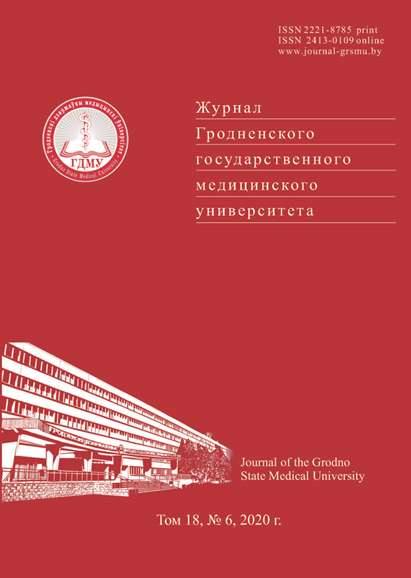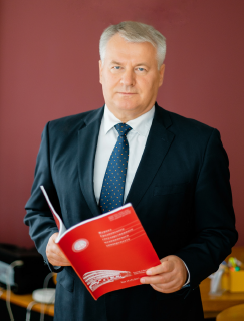ЧРЕСКОЖНЫЕ КОРОНАРНЫЕ ВМЕШАТЕЛЬСТВА – СОВРЕМЕННОЕ СОСТОЯНИЕ ВОПРОСА: ПРОФИЛАКТИКА ОСЛОЖНЕНИЙ И ПЕРСПЕКТИВЫ РАЗВИТИЯ

Аннотация
Антиагрегантная терапия – обязательная составляющая профилактики сердечно-сосудистых осложнений у пациентов с ишемической болезнью сердца (ИБС). Повреждение сосудистой стенки при выполнении чрескожных коронарных вмешательств (ЧКВ) сопровождается значительной активацией тромбоцитов и неизбежно повышает риск тромбообразования в зоне стентирования, особенно до завершения эндотелизации, как в случае реваскуляризации у пациентов с острыми коронарными синдромами, так и с хроническими формами ИБС. Эффективное предупреждение ишемических осложнений после ЧКВ диктует необходимость двойной антитромбоцитарной терапии, в том числе в комбинации с антикоагулянтной терапией. Длительность комбинированной терапии определяется клинической ситуацией, соотношением риска ишемических и геморрагических событий, оценка которых – неотъемлемая часть лечебно-диагностического процесса. Технологическое совершенствование коронарных интервенций направлено на точную оценку атеросклеротического поражения коронарных артерий и необходимость реваскуляризации, минимизацию повреждения сосудистой стенки, ускорение эндотелизации, сокращение длительности антитромботической терапии без потери долговременной эффективности реваскуляризации и повышения риска тромбоза стента. В представленном обзоре обсуждаются профилактика осложнений после ЧКВ с фокусом на антитромботическую терапию, а также перспективные технологии ЧКВ.
Литература
Valgimigli M, Bueno H, Byrne RA, Collet J-P, Costa F, Jeppsson A, Jüni P, Kastrati A, Kolh P, Mauri L, Montalescot G, Neumann F-J, Petricevic M, Roffi M, Steg P-G, Windecker S, Zamorano JL, Levine GN. 2017 ESC focused update on dual antiplatelet therapy in coronary artery disease developed in collaboration with EACTS: The Task Force for dual antiplatelet therapy in coronary artery disease of the European Society of Cardiology (ESC) and of the European Association for Cardio-Thoracic Surgery (EACTS). Eur Heart J. 2018;39(3):213-260. http://doi.org/10.1093/eurheartj/ehx419.
Mega JL, Braunwald E, Wiviott SD, Bassand J-P, Bhatt DL, Bode C, Burton P, Cohen M, Cook-Bruns N, Fox KA, Goto S, Murphy SA, Plotnikov AN, Schneider D, Sun X, Verheugt FW, Gibson CM. Rivaroxaban in patients with a recent acute coronary syndrome. N Engl J Med. 2012;366(1):9-19. http://doi.org/10.1056/NEJMoa1112277.
Eikelboom JW, Connolly SJ, Bosch J, Dagenais GR, Hart RG, Shestakovska O, Diaz R, Alings M, Lonn EM, Anand SS, Widimsky P, Hori M, Avezum A, Piegas LS, Branch KRH, Probstfield J, Bhatt DL, Zhu J, Liang Y, Maggioni AP, Lopez-Jaramillo P, O’Donnell M, Kakkar AK, Fox KAA, Parkhomenko AN, et al. Rivaroxaban with or without Aspirin in Stable Cardiovascular Disease. N Engl J Med. 2017;377(14):1319-1330. http://doi.org/10.1056/NEJMoa1709118.
Lip GYH, Collet J-P, Haude M, Byrne R, Chung EH, Fauchier L, Halvorsen S, Lau D, Lopez-Cabanillas N, Lettino M, Marin F, Obel I, Rubboli A, Storey RF, Valgimigli M, Huber K. 2018 Joint European consensus document on the management of antithrombotic therapy in atrial fibrillation patients presenting with acute coronary syndrome and/or undergoing percutaneous cardiovascular interventions: a joint consensus document of the European Heart Rhythm Association (EHRA), European Society of Cardiology Working Group on Thrombosis, European Association of Percutaneous Cardiovascular Interventions (EAPCI), and European Association of Acute CardiacCare (ACCA) endorsed by the Heart Rhythm Society (HRS), Asia-Pacific Heart Rhythm Society (APHRS), Latin America Heart Rhythm Society (LAHRS), and Cardiac Arrhythmia Society of Southern Africa (CASSA). Europace. 2019;21(2):192-193. http://doi.org/10.1093/europace/euy174.
Dzeshka MS, Lip GY. Stroke And Bleeding Risk Assessment: Where Are We Now? J Atr Fibrillation. 2014;6(6):49-57. http://doi.org/10.4022/jafib.1042.
Dzeshka MS, Brown RA, Lip GY. Patients with atrial fibrillation undergoing percutaneous coronary intervention. Current concepts and concerns: part I. Pol Arch Med Wewn. 2015;125(1-2):73-81. http://doi.org/10.20452/pamw.2650.
Dzeshka MS, Brown RA, Capodanno D, Lip GY. Antiplatelet and Antithrombotic Therapy in Patients with Atrial Fibrillation Undergoing Coronary Stenting. Interv Cardiol Clin. 2017;6(1):91-117. http://doi.org/10.1016/j.iccl.2016.08.007.
Dzeshka MS, Brown RA, Lip GY. Patients with atrial fibrillation undergoing percutaneous coronary intervention: current concepts and concerns: part II. Pol Arch Med Wewn. 2015;125(3):172-180. http://doi.org/10.20452/pamw.2711.
Capodanno D, Huber K, Mehran R, Lip GYH, Faxon DP, Granger CB, Vranckx P, Lopes RD, Montalescot G, Cannon CP, Ten Berg J, Gersh BJ, Bhatt DL, Angiolillo DJ. Management of Antithrombotic Therapy in Atrial Fibrillation Patients Undergoing PCI: JACC State-of-the-Art Review. J Am Coll Cardiol. 2019;74(1):83-99. http://doi.org/10.1016/j.jacc.2019.05.016.
Dzeshka MS, Pastori D, Lip GYH. Direct oral anticoagulant reversal: how, when and issues faced. Expert Rev Hematol. 2017;10(11):1005-1022. http://doi.org/10.1080/17474086.2017.1379896.
Dzeshka MS, Lip GYH. Reversal agents in the era of non-vitamin K antagonists oral anticoagulants: Necessity or psychological crutch? Trends Cardiovasc Med. 2020;30(2):91-92. http://doi.org/10.1016/j.tcm.2019.04.007.
Lopes RD, Hong H, Harskamp RE, Bhatt DL, Mehran R, Cannon CP, Granger CB, Verheugt FWA, Li J, Ten Berg JM, Sarafoff N, Gibson CM, Alexander JH. Safety and Efficacy of Antithrombotic Strategies in Patients with Atrial Fibrillation Undergoing Percutaneous Coronary Intervention: A Network Meta-analysis of Randomized Controlled Trials. JAMA Cardiol. 2019;4(8):747-755. http://doi.org/10.1001/jamacardio.2019.1880.
Potpara TS, Mujovic N, Proietti M, Dagres N, Hindricks G, Collet J-P, Valgimigli M, Heidbuchel H, Lip GYH. Revisiting the effects of omitting aspirin in combined antithrombotic therapies for atrial fibrillation and acute coronary syndromes or percutaneous coronary interventions: meta-analysis of pooled data from the PIONEER AF-PCI, RE-DUAL PCI, and AUGUSTUS trials. Europace. 2020;22(1):33-46. http://doi.org/10.1093/europace/euz259.
Dzeshka MS, Lip GY. Non-vitamin K oral anticoagulants in atrial fibrillation: Where are we now? Trends Cardiovasc Med. 2015;25(4):315-336. http://doi.org/10.1016/j.tcm.2014.10.017.
Chernyak AA, Snezhitskiy VA, Janushko AV, Dzeshka MS, Maksimchik AV. Voronovich AG, Avdejchik SV, Gabrijanchik GP, Gadzhieva FG, Ibrahimova DS. Sravnenie standartnogo i distalnogo luchevogo dostupa pri provedenii koronaroangiografii i chreskozhnogo koronarnogo vmeshatelstva. [Comparison of standard and distal radiated access in conducting coronarogiography andintertracial coronary intervention]. Zhurnal Grodnenskogo gosudarstvennogo medicinskogo universiteta [Journal of the Grodno State Medical University]. 2019;17(4):468-473. http://doi.org/10.25298/2221-8785-2019-17-4-468-473.(Russian).
Urban P, Meredith IT, Abizaid A, Pocock SJ, Carrie D, Naber C, Lipiecki J, Richardt G, Iñiguez A, Brunel P, Valdes-Chavarri M, Garot P, Talwar S, Berland J, Abdellaoui M, Eberli F, Oldroyd K, Zambahari R, Gregson J, Greene S, Stoll H-P, Morice M-C. Polymer-free Drug-Coated Coronary Stents in Patients at High Bleeding Risk. N Engl J Med. 2015;373(21):2038-2047. http://doi.org/10.1056/NEJMoa1503943.
Windecker S, Latib A, Kedhi E, Kirtane AJ, Kandzari DE, Mehran R, Price MJ, Abizaid A, Simon DI, Worthley SG, Zaman A, Hudec M, Poliacikova P, Abdul Ghapar AKB, Selvaraj K, Petrov I, Mylotte D, Pinar E, Moreno R, Fabbiocchi F, Pasupati S, Kim H-S, Aminian A, Tie C, Wlodarczak A, et al. Polymer-based or Polymer-free Stents in Patients at High Bleeding Risk. N Engl J Med. 2020;382(13):1208-1218. http://doi.org/10.1056/NEJMoa1910021.
von Birgelen C, Sen H, Lam MK, Danse PW, Jessurun GAJ, Hautvast RWM, van Houwelingen GK, Schramm AR, Gin RMTJ, Louwerenburg JW, de Man FHAF, Stoel MG, Löwik MM, Linssen GCM, Saïd SAM, Nienhuis MB, Verhorst PMJ, Basalus MWZ, Doggen CJM, Tandjung K. Third-generation zotarolimus-eluting and everolimus-eluting stents in all-comer patients requiring a percutaneous coronary intervention (DUTCH PEERS): a randomised, single-blind, multicentre, non-inferiority trial. Lancet. 2014;383(9915):413-423. http://doi.org/10.1016/s0140-6736(13)62037-1.
Zocca P, Kok MM, Tandjung K, Danse PW, Jessurun GAJ, Hautvast RWM, van Houwelingen KG, Stoel MG, Schramm AR, Gin RMTJ, de Man FHAF, Hartmann M, Louwerenburg JHW, Linssen GCM, Löwik MM, Doggen CJM, von Birgelen C. 5-Year Outcome Following Randomized Treatment of All-Comers with Zotarolimus-Eluting Resolute Integrity and Everolimus- Eluting PROMUS Element Coronary Stents: Final Report of the DUTCH PEERS (TWENTE II) Trial. JACC Cardiovasc Interv. 2018;11(5):462-469. http://doi.org/10.1016/j.jcin.2017.11.031.
Siontis GCM, Stefanini GG, Mavridis D, Siontis KC, Alfonso F, Perez-Vizcayno MJ, Byrne RA, Kastrati A, Meier B, Salanti G, Jüni P, Windecker S. Percutaneous coronary interventional strategies for treatment of instent restenosis: a network meta-analysis. Lancet. 2015;386(9994):655-664. http://doi.org/10.1016/S0140-6736(15)60657-2.
Giacoppo D, Gargiulo G, Aruta P, Capranzano P, Tamburino C, Capodanno D. Treatment strategies for coronary instent restenosis: systematic review and hierarchical Bayesian network meta-analysis of 24 randomised trials and 4880 patients. BMJ. 2015;351:h5392. http://doi.org/10.1136/bmj.h5392.
Pleva L, Kukla P, Zapletalova J, Hlinomaz O. Long-term outcomes after treatment of bare-metal stent restenosis with paclitaxel-coated balloon catheters or everolimus- eluting stents: 3-year follow-up of the TIS clinical study. Catheter Cardiovasc Interv. 2018;92(6):E416-E424. http://doi.org/10.1002/ccd.27688.
Baan JJr, Claessen BE, Boerlage-van Dijk K, Vendrik J, van der Schaaf RJ, Meuwissen M, van Royen N, Gosselink ATM, van Wely MH, Dirkali A, Arkenbout EK, de Winter RJ, Koch KT, Sjauw KD, Beijk MA, Vis MM, Wykrzykowska JJ, Piek JJ, Tijssen JGP, Henriques JPS. A Randomized Comparison of Paclitaxel-Eluting Balloon Versus Everolimus-Eluting Stent for the Treatment of Any In-Stent Restenosis: The DARE Trial. JACC Cardiovasc Interv. 2018;11(3):275-283. http://doi.org/10.1016/j.jcin.2017.10.024.
Yerasi C, Case BC, Forrestal BJ, Torguson R, Weintraub WS, Garcia-Garcia-Garcia HM, Waksman R. Drug- Coated Balloon for De Novo Coronary Artery Disease: JACC State-of-the-Art Review. J Am Coll Cardiol. 2020;75(9):1061-1073. http://doi.org/10.1016/j.jacc.2019.12.046.
Price MJ, Saito S, Shlofmitz RA, Spriggs DJ, Attubato M, McLaurin B, Popma Almonacid A, Brar S, Liu M, Moe E, Mehran R. First Report of the Resolute Onyx 2.0-mm Zotarolimus-Eluting Stent for the Treatment of Coronary Lesions with Very Small Reference Vessel Diameter. JACC Cardiovasc Interv. 2017;10(14):1381-1388. http://doi.org/10.1016/j.jcin.2017.05.004.
Gareri C, De Rosa S, Indolfi C. MicroRNAs for Restenosis and Thrombosis after Vascular Injury. Circ Res. 2016;118(7):1170-1184. http://doi.org/10.1161/CIRCRESAHA.115.308237.
Santulli G, Wronska A, Uryu K, Diacovo TG, Gao M, Marx SO, Kitajewski J, Chilton JM, Akat KM, Tuschl T, Marks AR, Totary-Jain H. A selective microRNA-based strategy inhibits restenosis while preserving endothelial function. J Clin Invest. 2014;124(9):4102-4114. http://doi.org/10.1172/JCI76069.
Kutryk M, Kuliszewski M. In vivo endothelial progenitor cell seeding for the accelerated endothelialization of endovascular devices. Am J Cardiol. 2003;92(Suppl 6A):94L-95L.
Klomp M, Beijk MA, de Winter RJ. Genous endothelial progenitor cell-capturing stent system: a novel stent technology. Expert Rev Med Devices. 2009;6(4):365-375. http://doi.org/10.1586/erd.09.16.
Woudstra P, Kalkman DN, den Heijer P, Menown IBA, Erglis A, Suryapranata H, Arkenbout KE, Iñiguez A, van’t Hof AWJ, Muller P, Tijssen JGP, de Winter RJ. 1-Year Results of the REMEDEE Registry: Clinical Outcomes After Deployment of the Abluminal Sirolimus-Coated Bioengineered (Combo) Stent in a Multicenter, Prospective All-Comers Registry. JACC Cardiovasc Interv. 2016;9(11):1127-1134. http://doi.org/10.1016/j.jcin.2016.02.052.
Gori T, Polimeni A, Indolfi C, Räber L, Adriaenssens T, Munzel T. Predictors of stent thrombosis and their implications for clinical practice. Nat Rev Cardiol. 2019;16(4):243-256. http://doi.org/10.1038/s41569-018-0118-5.
Cassese S, Byrne RA, Tada T, Pinieck S, Joner M, Ibrahim T, King LA, Fusaro M, Laugwitz K-L, Kastrati A. Incidence and predictors of restenosis after coronary stenting in10 004 patients with surveillance angiography. Heart. 2014;100(2):153-159. http://doi.org/10.1136/heartjnl-2013-304933.
Xaplanteris P, Fournier S, Pijls NHJ, Fearon WF, Barbato E, Tonino PAL, Engstrøm T, Kääb S, Dambrink J-H, Rioufol G, Toth GG, Piroth Z, Witt N, Fröbert O, Kala P, Linke A, Jagic N, Mates M, Mavromatis K, Samady H, Irimpen A, Oldroyd K, Campo G, Rothenbühler M, Jüni P, et al. Five-Year Outcomes with PCI Guided by Fractional Flow Reserve. N Engl J Med. 2018;379(3):250-259. http://doi.org/10.1056/NEJMoa1803538.
Zhuang B, Wang S, Zhao S, Lu M. Computed tomography angiography-derived fractional flow reserve (CT-FFR) for the detection of myocardial ischemia with invasive fractional flow reserve as reference: systematic review and meta-analysis. Eur Radiol. 2020;30(2):712-725. http://doi.org/10.1007/s00330-019-06470-8.




























